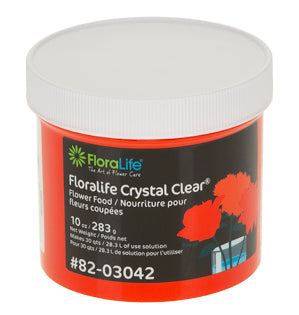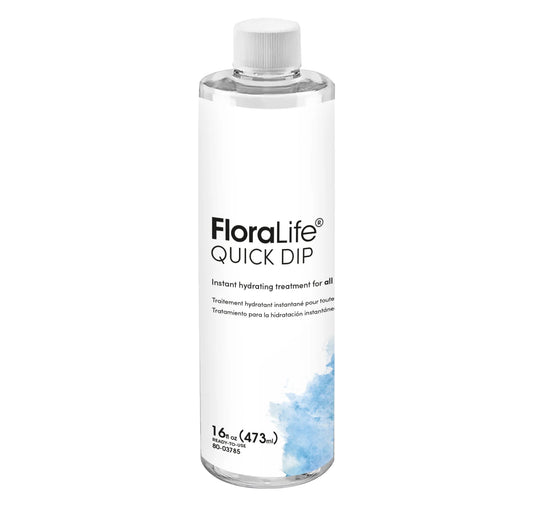Blue Flower Garden
Bring the garden inside to enjoy by creating a vegetative-style landscape design that really showcases each flower's unique stem and bloom. Th is a style that can really let your flowers reach tall in a design. In this Flower School How-To Video Leanne works with a cheerful assortment of blue and white flowers, including gentian, bachelor buttons, veronica, narcissus, and more. It's Spring in a box - enjoy!
Video Transcription
Being a city girl, I love to design in the garden format, that vegetative style, bringing the garden inside. As I create this design with you today, you'll learn a new technical term, wonky. Be sure to watch for it.
When I was gathering flowers for the garden, I wanted blue, and as a florist, you know blue is tricky. But this time of year there are a few things and I found three that are fabulous. Now, yes, they're a little bit purple as well, and most blues are. But paired together with white, it'll give the look of blue and white, kind of that Delft look. I have allium, bachelor buttons, and gentian, which will pair in with the narcissus, veronica, and a bit of spirea.
As I work, I think about vertical lines, vegetative, straight up and down. It's a contemporary version, no central binding point. With the spirea, it's so woody, I oftentimes just break it. Now, you'll notice the foam is not taped. It's snuggly in here, so it doesn't need to be taped. It's not going to jump around. I'm just placing the stems vertically, some in the middle, some in the back, some coming towards the front. You want it to fill the entire box, repeating the placement. Some can be a little lower, paired together. Others a little bit taller. Then going back and repeating it. Bringing in the allium. Won't stay up and down? You can group it up and down, some lower. But think about as a plant would grow so the grouping has a little tiny bit of movement. Maybe shorten that one a bit so that it pulls your eye to the back, so it's shadowed behind the other. Repeating. Another grouping. Then coming in with the gentian. It's so bold. It has leaves. Sometimes I remove them, other times I leave them. Depends on what you like in your arrangement, how much negative space you want to leave. Tucking it in. And then turning it and looking at it from both sides to make sure that it's beautiful from the front and the back.
Now that I have all my sleek lines placed, time to add a little bit of dynamic movement. The lysimachia, a bit of a gooseneck, that's where it gets it common name from. It changes the overall appearance, adding that little bit of movement crosswise, which makes it so much more interesting. You can go both directions, finding the perfect spot for it, then coming in with the bachelor buttons and leaving their buds. It gives it a weedier look, so that again, it's not quite so pristine. You're softening the garden by enhancing it with just a few contradictory moves. Again, tucking it, letting the buds come out. And then the narcissus, using them low to bring that lighter color all the way down to the bottom, so it keeps the eye going from the top to the bottom and through the middle.
To finish, I just need to cover my mechanics, create a ground cover. One of my favorites is to use fresh sphagnum moss and just tuck it down in. Now, you may ask, "Well, why didn't you do that first?" When you do it first and you're inserting your stems through the moss, often times it grabs the moss, pulls it into the foam, chews up the moss, and then makes your stems go wonky. They won't stay straight. Even though it's a little harder to feed it in between the stems, it's my preferred way. Then in addition to that, taking a few leaves. I like the galax, you know it's one of my favorites, and just placing them to help break the line of the container to carry the green foliage of the flowers all the way down to the bottom.
The recipe, it's all built on floral foam in a lined container. Then I added in 10 stems of the Spirea, broken apart and spread around, then I went to seven Gentian and seven of the Allium. Then moving on to the next step was seven of the Bachelor Button's, seven of Veronica, then back to 10 for the Narcissus. Then the ground cover, a combination of Sphagnum Moss and Galax Leaves. I used 10 of these to finish front to back.
The spring and summer months, to me, shout for this natural growing format, but there are so many more options. You'll find more creative inspiration on the website, FlowerSchool.com. If you have questions, you can reach us through there, but now it's your turn. What are you going to create in the vegetative manner? Be sure to take a picture, post it on social media and #FloralDesignInstitute. That way we all can see what you do as you do something you love.






